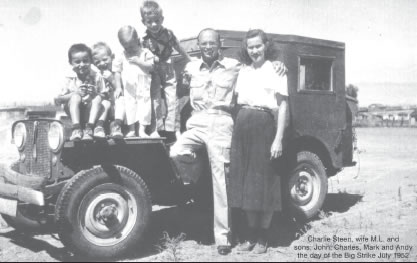Charlie Steen’s
Uranium Discovery - July 6, 1952
by Jeff Richards
Fifty-one years ago,
on July 6, 1952, a geologist from Texas named Charles Steen,
down on his luck and about to give up after two years of
fruitless searching for uranium deposits in the area, finally
struck it rich at his Mi Vida claim in Lisbon Valley southeast
of Moab. After breaking his last drill bit, or so the story
goes, the frustrated and penniless Steen ran a Geiger counter
over the core samples and found that he’d hit a vein
of uranium-rich ore at 173 feet. The Mi Vida mine alone
would ultimately be worth more than $100 million, and it
put Moab on the map. By the end of 1956, Moab was dubbed
“The Richest Town in the USA” in a national
magazine article. A sign in town proudly proclaimed Moab
as “The Uranium Capital of the World.”

In the wake of Steen’s discovery, thousands of prospectors,
miners, laborers, and others descended on the area, hoping
to cash in on the mother lode. Uranium was highly sought
after by the federal government, primarily for use in Cold-War
era atomic weapons and in nuclear power plants.
Moab, which had between 1,000 and 1,300 people between 1950
and 1952, more than quadrupled in population over the next
few years, and by the end of 1956 the city’s population
was nearly 6,000, just slightly smaller than it is today.
By some accounts, the town had as many as two dozen millionaires
in 1956, although some were merely “paper millionaires”
whose wealth evaporated when their stock became worthless
after the boom died down a few years later.
Of these millionaires, Charlie Steen himself was certainly
the richest and most flamboyant. He built a lavish house
with a swimming pool on top of a hill overlooking Moab.
Steen and his wife Minnie Lee (M.L.) hosted many parties
at their home over the years, attracting corporate types,
politicians, and Hollywood celebrities. Stories about Steen
and the eccentric ways he spent his money remain the stuff
of local legend.
By the early 1960s, the boom had died out, only to resurface
when additional uranium deposits were located just north
of the Mi Vida site. This second boom lasted until the mid-1960s,
then tapered off. However, just as uranium died out, mining
operations began in 1965 in one of the largest potash deposits
in the world (on the Colorado River between Moab and Dead
Horse Point), and work continues there today.
Mining has long been important to Moab, which lies within
a unique geological formation called the Paradox Salt Basin.
This basin has various accumulations of valuable minerals
relatively near the surface. Uranium was mined in the nearby
La Sal mountains as early as the 19th century. The famous
scientist Marie Curie, who discovered the element radium
in uranium ore in 1898, visited the Moab area herself in
1899 and inspected a uranium processing plant that French
scientists had set up near the Dolores River in southwestern
Colorado.
Other valuable materials mined in the Moab area over the
years include vanadium (used in steel processing), lead,
gold, copper, silver, along with helium, natural gas, and
oil. Mining towns such as Castleton sprung up all over the
La Sals and the Utah-Colorado border during the first three
decades of the 1900s, only to become ghost towns in the
years thereafter.
But it was Steen’s Mi Vida strike that made Moab a
nationwide household name. This is a distinction that Moab
still enjoys, although the uranium era has long since ended.
Today, Moab’s economy thrives on a boom of a different
kind—that of tourism. Visitors come to Moab to sightsee
and go mountain biking, river rafting, four-wheeling, and
do many other outdoor activities.
Steen, now in his eighties and reportedly afflicted with
Alzheimer’s, lives in Colorado with his son. Although
much of his fortune is either gone or tied up in various
legal squabbles, Charlie Steen still owns a lot of property
around Moab, including his famous home on the hill. The
house later became the Mi Vida Restaurant, and then changed
its name to the Sunset Grill in 1995. John and Laurie Clayton
have owned and operated the restaurant business since 1993.
The Sunset Grill’s printed menus enlighten restaurant
patrons about the building’s illustrious history.
From the restaurant, diners today can see a spectacular
view of the entire Moab valley, including Steen’s
old uranium mill with its tailings pile on the banks of
the Colorado River. The rags-to-riches-to-rags story behind
that pile of dirt and the abandoned buildings around it
provides a poignant and lasting reminder that whatever goes
up must eventually come down.
Last year, on July 4, 2002, a special plaque was unveiled
at the Charlie Steen Pavilion in Moab’s Swanny City
Park, commemorating the 50th anniversary of Steen’s
famous find.
